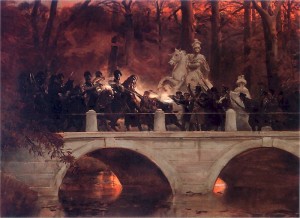
On this day in 1830, Polish cadets, tired of being under the thumb of Russia after being partitioned post-Napoleonic wars, decided to revolt to free Poland from tyranny. While initially successful locally, they were eventually crushed by the better equipped and numerically superior Russia army.
Poland had been partitioned between Prussia, Russia and the Hapsburg Empire in 1795 and completely enveloped by Austria, Russia and Prussia in 1815 due to its aid to Napoleon. Poland was supposedly a autonomous country with a constitution but was allied to Russia through the Tsar as King of Poland. Increasingly, over the years, the Tsar’s, Alexander I (Episode 53) then Nicholas I (Episode 56) disregarded the constitution entirely. Instead they made Poland their fiefdom and did as they pleased. This stewed a growing animosity among the entire population and in particular, the nobility and military.
In 1815, Alexander I appointed Grand Duke Constantine Pavlovich, his brother, as viceroy of Poland. Constantine was considered a tyrant by the Polish people who despised him. On November 29th, things began to boil over. A group of young cadets, led by Piotr Wysocki attacked the Belwedere Palace where the Grand Duke lived, trying to capture him. They were unsuccessful as Constantine escaped wearing women’s clothing.
Prince Adam Jerzy Czartoryski tried to negotiate a peaceful resolution with the Grand Duke who initially agreed to be lenient with the cadets but radical members of the Polish military and government rejected the offer. All but two of the General’s of the Polish army went over to the rebels. A provisional government was formed with General Jozef Chłopicki being named Dictator of the Uprising.
Chlopicki did not favor a war with Russia as he felt there was no way it would be successful but he bowed to the pressure of the people. He tried to quell the uprising by appealing to Tsar Nicholas I by sending Count Drucki-Lubecki to St. Petersburg. The mission was futile. The Tsar demanded full capitulation or face military intervention.
The Sejm, the governing body of the Polish government declared that the union between Poland and Russia was null and void on January 25, 1831. They proclaimed that “the Polish nation is an independent people and has a right to offer the Polish crown to him whom it may consider worthy, from whom it might with certainty expect faith to his oath and wholehearted respect to the sworn guarantees of civic freedom.” It was, for all intents and purposes a declaration of war.
Without going into details, the war did not go well for Poland. By October 5th, 1831, the last of the rebellious troops crossed the border to Prussia and laid down their arms. Over 40,000 Poles were either killed or wounded. The Russians suffered around 23,000 killed or wounded with an additional 5-12,000 dying of disease. While many historians believe that Poland could have won the war had they been more unified but the fact remains that the resources of Russia were far too great for a successful Polish outcome.
3 replies on “Poland and the November Uprising”
The best fighter is one who manages to transform an enemy into a best friend. How true.
All this trouble just to put down a comment. Man.
Okay, so, are you an expert in this, or did you just make it up for fun? I kind of, no, I need to know. I’m writing a report that has to do with the November Uprising, so your information needs to be correct.
Pretty much an expert. You can listen to my over 170 podcasts on Russian history over at http://podhoster.russianrulers.com . Sorry for the problems posting a comment but you wouldn’t believe how much spam is sent.